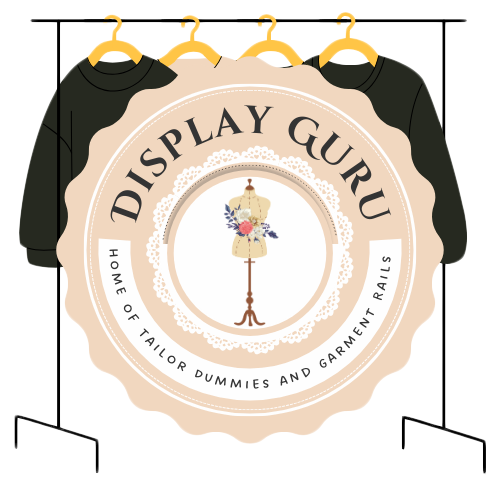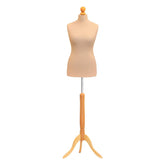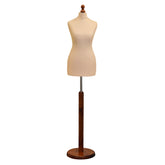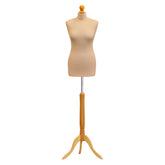What Is Fashion Merchandising? Key Insights & Career Tips
Ever walked into a shop and felt like it was curated just for you? That’s not a happy accident; it’s the result of expert fashion merchandising. In essence, it’s the crucial business of getting the right fashion product to the right customer, at the right time, in the right place, and for the right price.
It’s the engine room of the fashion industry, ensuring the creative vision of designers translates into commercial success on the shop floor.
The Art and Science of Selling Style
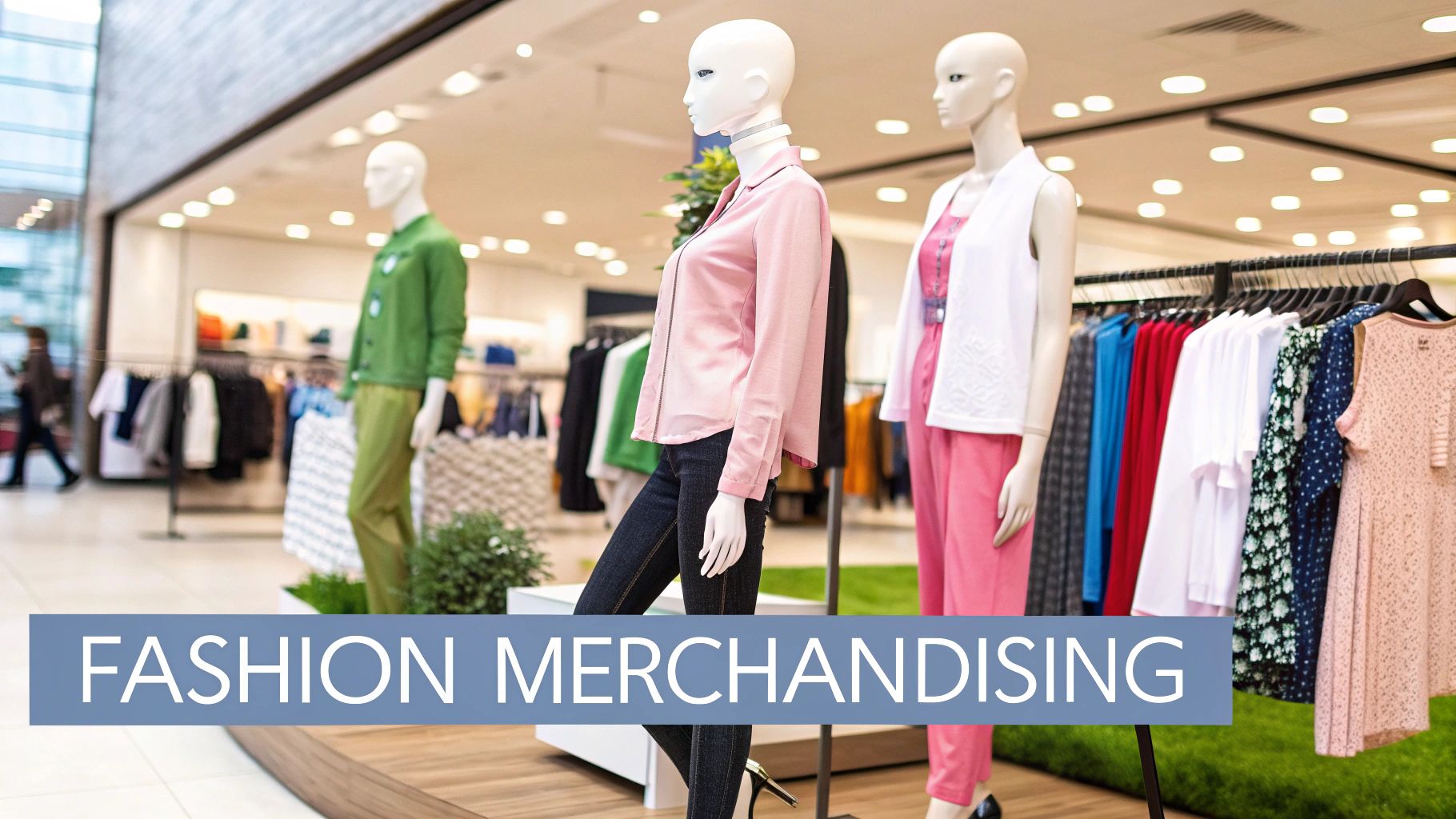
Think of a fashion merchandiser as the bridge between the design studio and the customer. While a designer brings a collection to life, the merchandiser is the master strategist who ensures it sells. They are part artist, part analyst, blending a sharp eye for style with a deep understanding of data.
This isn't just about having good taste. It's about digging into sales figures, predicting future trends, managing stock levels, and ultimately, making sure a brand is profitable. With the UK apparel market hitting around £64.5 billion in 2023, the stakes are incredibly high. Merchandisers are the ones who make the tough calls that determine whether a brand thrives or fails in this competitive space.
At its core, fashion merchandising is guided by a timeless principle known as the "Five Rights." Mastering these is the key to transforming creative vision into retail revenue.
Everything a merchandiser does is aimed at perfectly synchronising the product's journey with what customers actually want to buy. This ranges from forecasting which colours will dominate next season to deciding the precise number of winter coats to stock in a Manchester store versus a coastal Brighton boutique.
It’s a series of calculated decisions designed to ensure products don't just hang on a rail but fly out the door. This strategic oversight even extends to how items are presented in-store, a discipline you can explore further in our essential visual merchandising guidelines.
This set of core principles is the foundation of any successful merchandising strategy. Getting them right is what separates a fleeting trend from a profitable, enduring brand.
The Five Rights of Fashion Merchandising
| Principle | Description |
|---|---|
| The Right Product | Offering items that align with your target audience's style, needs, and quality expectations. This is about knowing your customer inside and out. |
| The Right Price | Setting a price point that reflects the product's value, resonates with the customer's budget, and achieves the brand's profit margins. |
| The Right Place | Ensuring products are available where your customers shop, whether that's a specific high street store, an online marketplace, or a brand's e-commerce site. |
| The Right Time | Timing is everything. This means stocking seasonal items (like swimwear or winter coats) just as customers begin looking for them. |
| The Right Quantity | A delicate balance between having enough stock to meet demand without overstocking, which leads to markdowns and lost profit. |
Mastering these five elements isn't just a box-ticking exercise; it's a continuous cycle of planning, analysis, and adaptation. It's the framework that helps merchandisers make smart, profitable decisions every single day.
The Merchandising Journey From Concept To Customer
Ever wonder how a fleeting fashion idea becomes the must-have item in a customer's wardrobe? That journey is a long and carefully planned road, and the fashion merchandiser is the one drawing the map every step of the way. It’s a sophisticated process that turns creative sparks into commercial success, making sure the final product not only looks good but sells well.
This cycle of analysis, planning, and action starts long before a single stitch is made.
The Spark: Trend Forecasting and Market Research
The first phase is all about trend forecasting and market research. Think of merchandisers as cultural detectives. They’re deep-diving into runway shows, keeping a close eye on competitors, tracking social media trends, and, most critically, pouring over past sales data. Their mission? To predict what people will want to buy six to twelve months from now.
From Insights to Initial Designs
Once a clear picture of future demand starts to form, the merchandiser translates these abstract findings into solid product briefs for the design team. This isn’t as simple as saying, "let's do florals". It's about defining specific silhouettes, pinpointing exact colour palettes, setting target price points, and selecting key fabrics. The aim is to build a collection framework that gives designers creative freedom while staying commercially grounded.
As the design team develops initial concepts, the merchandiser is right there, providing feedback to ensure every piece aligns with the business strategy and financial goals. This back-and-forth is crucial for balancing creative vision with commercial reality.
The following chart breaks down this flow, from initial analysis right through to the final in-store presentation.
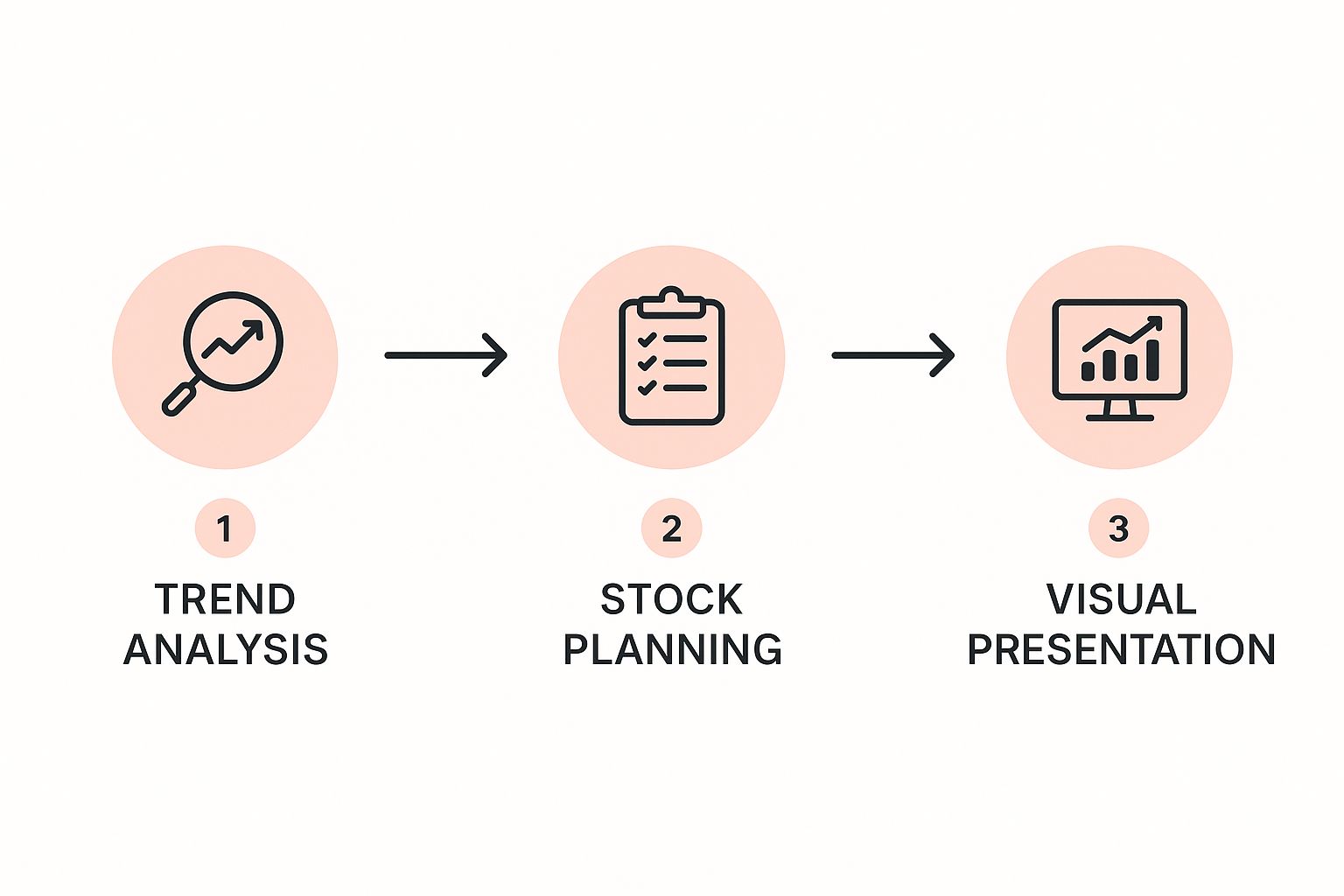
As you can see, each stage builds logically on the last, creating a product story that’s both cohesive and profitable.
Production and Strategic Allocation
With designs locked in, the journey moves into sourcing and production. Here, merchandisers work hand-in-glove with suppliers to find the right materials and negotiate manufacturing costs. They make tough decisions every day, striking a delicate balance between quality, cost, and lead times. This ensures the product can hit its target retail price and still deliver a healthy profit margin.
Once the items are produced, the focus pivots to allocation and distribution. A merchandiser decides which stores get which products, and in what quantities. It’s a strategic puzzle. For example, a flagship store in central London will get a very different product mix and stock level than a smaller shop in a regional town. These decisions are driven purely by data on local customer demographics and sales history.
The ultimate goal is to get the right stock to the right place at the right time, maximising the chance of a full-price sale and avoiding costly markdowns later.
In-Season Management: The Final Mile
Finally, the journey reaches the in-season management phase. When products land on the shop floor, the merchandiser's job is far from done. They track sales performance daily, identifying best-sellers that might need a re-order and spotting slow movers that might need a price adjustment or a better position in the store.
The final presentation is often the key to unlocking an item's potential. Using effective retail display stands can make all the difference. This constant analysis allows the business to react quickly to what customers are actually buying, squeezing every last drop of potential from the season.
Exploring Careers in Fashion Merchandising
Fashion merchandising isn't just one job; it's a whole world of different but connected roles. Think of it like an ecosystem where every part works together to help a brand succeed. While everyone is pulling in the same direction—towards commercial success—what they do day-to-day can look very different. Knowing these distinctions is the first step to figuring out where you might fit in this dynamic industry.
The role most people think of first is the Retail Merchandiser. These are the guardians of what happens at the store level. They're the data wizards, making sure each shop has the right products, in the right sizes and quantities, to meet local tastes and demand. It's a highly analytical job, all about optimising stock and squeezing every bit of profit from the shop floor.
The Creative and The Analytical
On the other side of the coin, you have the Visual Merchandiser. They are the brand's storytellers. Their entire focus is on shaping the customer's experience inside the store, turning product strategy into visual magic. From a stunning window display that stops people in their tracks to the flow and feel of the entire shop layout, their job is to inspire, engage, and ultimately, persuade. It demands a sharp artistic eye fused with a solid grasp of customer psychology. You can get a feel for the precision required by reading our ultimate guide to using an adjustable mannequin for sewing, which covers getting those crucial fits just right.
Then there’s the Fashion Buyer, a role that’s part trend-spotter, part-negotiator. Buyers are the ones who decide which collections make it to the shelves. They spend their time at trade shows, meeting designers, and poring over market data to build a product mix that will genuinely connect with their customers. It’s a high-stakes position that directly shapes a brand's public identity and its bottom line.
Today's market is tougher than ever, forcing every role to be more strategic. For instance, recent reports show a 1.1% year-on-year drop in non-food sales in May, while UK retailers are facing an extra £5 billion in operational costs. This kind of pressure means merchandisers have to be incredibly sharp and agile. You can explore insights on the UK fashion sector's recent performance on just-style.com to understand more about these challenges.
Adapting to the Digital Shelf
The explosion of e-commerce has given rise to another vital specialism: the Digital Merchandiser. This role takes all the time-honoured principles of merchandising and applies them to the online world. Their job involves:
- Optimising where products appear on the website.
- Curating online collections and categories so they're easy to browse.
- Making sure product photos and descriptions are clear and compelling.
- Analysing website traffic and user behaviour to drive online sales.
Essentially, a Digital Merchandiser's goal is to make the online shopping journey as smooth, intuitive, and exciting as walking into a beautifully designed physical store.
So, whether you're drawn to crunching data, creative storytelling, or high-level negotiations, a career in fashion merchandising offers a rich variety of paths to leave your mark on a brand's journey.
The Modern Merchandiser's Essential Toolkit
A successful modern merchandiser doesn't just rely on a gut feeling for fashion. They operate with a powerful combination of time-honoured skills and essential technologies. To really succeed in fashion merchandising, you need a unique blend of artistry and analytics, demanding fluency in both creative expression and data-driven decisions.
This hybrid skill set is what truly separates a good merchandiser from a great one. It’s the ability to spot the next big trend while also understanding the cold, hard numbers that actually drive profitability.
Core Competencies For Success
A merchandiser's abilities can be grouped into three critical pillars. Each one is absolutely essential for navigating the complex journey from a product concept all the way to a customer's wardrobe.
- Analytical Skills: This is the bedrock of merchandising. It covers everything from sales forecasting and analysing historical data to spot patterns, to managing inventory levels to maximise sales and minimise waste. Strong numerical literacy is non-negotiable.
- Creative Skills: Beyond the spreadsheets, merchandisers need a sharp eye for product and trends. This means understanding aesthetics, colour theory, and exactly what makes a product visually irresistible to the target customer.
- Business Acumen: This is the glue that holds everything together. It involves budgeting, negotiating with suppliers to secure favourable costs, and understanding profit and loss statements to ensure the brand stays financially healthy.
A merchandiser’s role is to be the commercial conscience of the creative process, ensuring that every product decision is not just stylish, but also smart and sustainable for the business.
The Digital Toolbox Transforming The Industry
Today, these core skills are amplified by a suite of digital tools that allow for far greater precision and efficiency. The days of managing everything on paper are long gone; modern merchandising leans heavily on specialised software that provides critical insights and smooths out complex operations.
One of the most important categories is Enterprise Resource Planning (ERP) systems. Think of these as the central nervous system for the business. They integrate data from various departments—from inventory and sales to finance and supply chain—into a single, unified platform. This gives merchandisers a real-time, holistic view of the entire business.
Next up, Product Lifecycle Management (PLM) software is crucial for managing a product's journey from the first design sketch to final production. It helps teams collaborate, track development stages, and manage technical specifications, ensuring consistency and a faster route to market. For a deeper look into creating compelling product presentations, you can explore our guide on effective retail display solutions.
Here is an example of a visual merchandising software platform, Display Guru, which helps teams execute compelling store layouts.
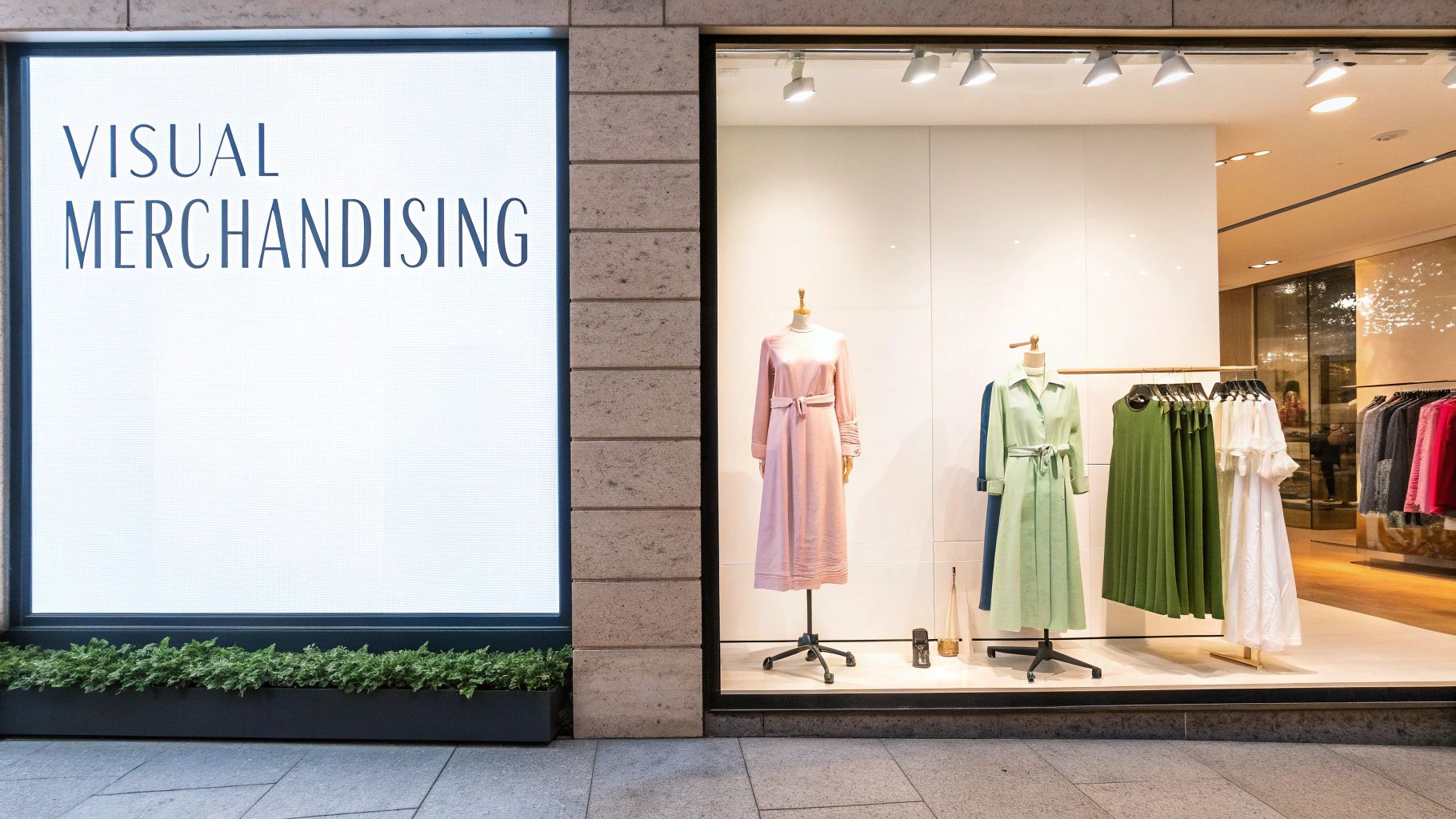
Platforms like this empower visual teams to plan, share, and implement store displays with precision, ensuring the brand’s story is told consistently across all physical locations. Ultimately, combining a sharp mind with technological fluency is what defines the modern, successful fashion merchandiser.
How Digital Is Reshaping Fashion Merchandising

The explosion of e-commerce has done more than just open up another place to sell clothes; it's fundamentally changed the game for fashion merchandisers. While the core mission—getting the right product to the right person—hasn't changed, the 'place' and 'time' are now instant, global, and constantly switched on. Thriving in this new world means adopting a whole new playbook designed for the digital shelf.
Online merchandising is a real art form. It's not just a matter of uploading a few product photos and hoping for the best. It's about crafting a narrative with compelling, high-quality images and persuasive descriptions. It also demands intuitive website navigation that lets customers find exactly what they’re looking for without any friction.
The Art of The Digital Storefront
A sharp digital merchandiser thinks of a website as their flagship store. Every single click is a deliberate step in a carefully curated customer journey. This means strategically positioning new arrivals, making heroes of best-sellers, and using data to generate personalised recommendations that make every shopper feel seen.
After a recent dip, UK e-commerce sales for textiles, clothing, and footwear are set to bounce back, with forecasters predicting a 4.6% growth to hit £21.01 billion. This resurgence underscores just how vital it is for merchandisers to get their digital strategy right, especially as mobile shopping and social commerce increasingly dictate how people buy. You can discover more about UK fashion e-commerce trends on eMarketer.
The core challenge for a digital merchandiser is to translate the tactile, sensory experience of in-store shopping into a compelling and seamless online journey.
Success here depends on making the online experience feel every bit as rich and engaging as a trip to a physical shop. This could mean using high-resolution videos to show the drape and movement of a fabric or creating incredibly detailed size guides. The same meticulous attention to detail needed to dress a mannequin applies to online presentation; you can read our guide on using a male tailor dummy to see how precision transforms fittings and get a sense of that precision.
Creating a Unified Omnichannel Strategy
Today's customers don’t see separate channels; they just see one brand. That makes an omnichannel strategy absolutely non-negotiable. The goal is to create a perfectly consistent and unified customer experience across every touchpoint, whether that’s the mobile app, the website, or the high street store.
In practice, this means merchandisers have to manage inventory across all these channels at once. They rely on sophisticated systems to offer popular services that elegantly blend the digital and physical worlds, such as:
- Click and Collect: Letting customers buy online and pick up their items from a nearby shop.
- In-Store Returns for Online Orders: Offering flexibility and making life easier for the customer.
- Real-Time Stock Visibility: Showing online shoppers what’s currently available in their local physical store.
By bringing data and stock together, merchandisers ensure the brand's story and promise are consistent everywhere. In a crowded market, that consistency is what builds trust, fosters loyalty, and turns one-time purchasers into lifelong fans.
Your Questions About Fashion Merchandising Answered
Diving into fashion merchandising for the first time can feel like learning a new language. It’s a world filled with specific roles, skills, and career paths that often seem to blend into other parts of the fashion industry. So, to cut through the noise, we've tackled some of the most common questions people have about this dynamic field.
This isn't a textbook definition. It’s a straightforward look at what the job really is, what it takes to get started, and how all the moving parts work together to make a brand successful. Let's clear up any confusion and give you a real-world understanding of a career in fashion merchandising.
What’s the Difference Between Fashion Merchandising and Fashion Design?
While both roles are absolutely essential, they represent two very different sides of the fashion coin. Think of fashion designers as the architects of style. They are the creative visionaries who dream up and craft the actual garments, obsessing over aesthetics, form, and how a piece is constructed.
Fashion merchandisers, on the other hand, are the strategic minds who make sure those designs can actually succeed in the real world. They dive into sales data and market trends to decide which products to make, how many to produce, and what the right price should be. They build the critical bridge between pure creativity and commercial success.
To put it simply: the designer creates the 'what' (the product), while the merchandiser figures out the 'how, when, and where' to sell it for a profit.
What Qualifications Do I Need to Become a Fashion Merchandiser?
There's no single, rigid path into merchandising, but the most solid foundation is usually a mix of formal education and practical experience. Many successful merchandisers have a degree in a related field like Fashion Merchandising, Fashion Business, or Retail Management. This gives you the theory and the business fundamentals.
However, nothing beats hands-on experience. Many of the industry's best started their journey on the shop floor as a sales associate or a Merchandising Admin Assistant (MAA). These roles offer an unparalleled education in what customers actually want, how products perform, and the daily rhythm of a retail business.
Regardless of your entry point, some skills are simply non-negotiable. You have to be comfortable with numbers and analysis, as a huge part of the job is interpreting data. Being a whiz with tools like Microsoft Excel isn't just a bonus; it's a fundamental requirement from day one.
How is Visual Merchandising Different From General Merchandising?
Visual merchandising is a specialist craft that sits within the wider world of fashion merchandising. A general fashion merchandiser has a broad remit, covering everything from product selection and pricing to stock management. A visual merchandiser’s focus is much sharper.
Their entire world is the 'look and feel' of the retail space. They are responsible for creating a complete sensory experience that tells the brand's story and makes customers want to buy. This includes:
- Designing captivating window displays that stop people in their tracks.
- Planning the store layout to create a logical and enjoyable customer journey.
- Creating compelling in-store product stories and styling mannequins.
In essence, a visual merchandiser’s job is to translate the product strategy into a tangible, shoppable, and exciting reality. They take the analytical decisions made by the merchandising team and turn them into an experience that inspires people to part with their money.
Is Fashion Merchandising a Good Career Choice?
If you have that rare blend of creative instinct and a sharp, analytical mind, then fashion merchandising can be an incredibly rewarding career. It’s a fast-paced, high-energy field that puts you right at the commercial heart of the industry. There's also a clear path for progression, from assistant levels all the way up to director and executive roles.
The job demands resilience and a cool head. You'll constantly be working towards ambitious sales targets and tight deadlines, so it's not for the faint-hearted. But for those who get a buzz from that kind of pressure, it's immensely stimulating.
If you love strategic problem-solving, enjoy digging into trends, and get a thrill from seeing your decisions directly boost the bottom line, then fashion merchandising offers a challenging and fulfilling career where no two days are ever the same.
Ready to perfect your in-store presentations and bring your merchandising strategy to life? Explore the professional-grade mannequins, garment rails, and display solutions at Display Guru. Our tools are designed to help you create stunning visual displays that captivate customers and drive sales. Check out our full range at https://www.displayguru.co.uk.
